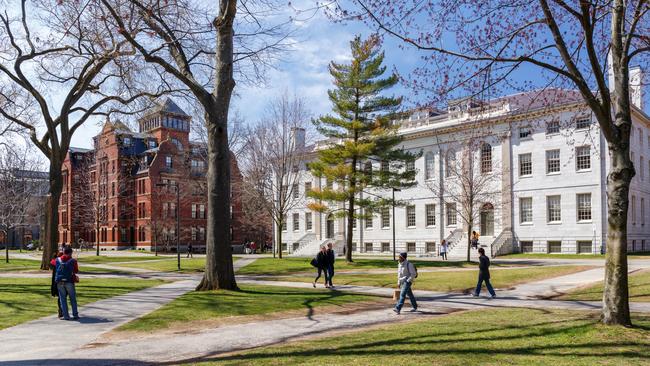US higher education trends point to opportunities for Australian unis
Our universities’ extensive links with American partners could come in handy amid turmoil in the US sector.

There are so many headlines coming out of Washington, DC, each day that it is a challenge to get beyond the hour-by-hour updates to see what is really going on under the surface.
We focus on the decisions being made by Donald Trump — in areas such as foreign and economic policy — because what America does matters for us in Australia. But there are significant changes happening in US education, research and innovation too, even if they don’t make the front pages.
The US university system is the best-known and most powerful in the world, and was this month ranked yet again as the highest performing globally.
In Australia, universities have focused most of their recent international attention and strategy on Asia, especially China, and have in many ways taken the American system for granted. Perhaps this is because of the breadth and quality of the links we have developed with US institutions over the past 70 years. But one thing is certain — the future for American universities will look very different from the past.
Why does this matter for us? Because the success of the American university system has inspired and materially affected the success of Australian universities. For the Australian National University, as for the rest of our system, the US has long been our No 1 research partner, on a scale far more extensive than our links with other countries. This collaboration has driven our research quality, citations and rankings.
But the US system is at a major inflection point. In their excellent 2015 book Designing the New American University, Arizona State University president Michael Crow and historian William Dabars describe how, in the decades after World War II, the system delivered unprecedented educational attainment, social and economic mobility, research-driven innovation and “global pre-eminence”. But they show how it is now in desperate need of renewal.
At the end of 2017, The New York Times columnist Frank Bruni summed up the year as “higher ed’s low moment”, setting out major challenges for US universities: spiralling costs, “illiberal liberalism” and the need to better explain the value of the institutions to society.
I see four underlying trends that have driven change in the US university system to this point: increasing political polarisation; a shift from public to private; changing views about internationalisation; and innovation. By monitoring these trends we can better understand what the future will hold for US universities and America more broadly, as well as our own institutions.
First, political and ideological polarisation. The flashpoint for the impact of this trend on universities was the mid-2017 Pew report that showed a rapid growth in the percentage of US conservatives who thought universities were having a negative effect on society, up to 58 per cent. The “free speech” debates on campuses are ongoing and passionately argued, placing enormous pressure on individuals and institutions. In congress, partisan battle lines are drawn over the re-authorisation of the Higher Education Act and the science budget.
These divides are also growing at the state level — some public higher education systems are faring well while others face huge shortfalls. And in states such as Oklahoma and West Virginia, opposition to public funding for education has led this year to primary schools being unable to open five days a week and teacher walkouts.
Declining public support is linked to the second trend — increasing privatisation. This is evident in research — in 2015, for the first time since World War II, less than 50 per cent of basic research was funded by government. Space R & D, for example, is deliberately being transferred from the public to the private sector with the rapid development of companies such as Elon Musk’s SpaceX.
The same shift is also happening in education, with the expansion of for-profit providers and their new forms of alliances with public institutions. It is also clear in the continuing expansion of privately held student debt, which poses increasing risks to families and the economy as a whole. Last year, for the first time public universities and colleges in a majority of states received more revenue from student tuition than government appropriations.
The third trend — changing views about internationalisation — shows how universities are at the forefront of bigger debates about immigration and globalisation. The Institute of International Education’s 2017 Open Doors report shows a decline in new enrolments by international students in the US. Australian Geoffrey Garrett, the dean of the Wharton School at the University of Pennsylvania, has described the nexus between immigration and innovation as the “secret sauce” of the US economy and warned about a loss of talent.
But the Open Doors report also shows an ongoing increase in the number of young Americans studying abroad.
Finally, this brings us to innovation, perhaps America’s defining feature, and one in which universities have historically played such a key role. The question is not whether US innovation will continue, but in which direction. In response to these other trends — and as part of a society that is itself subject to rapid disruption — universities are not alone in experimenting with all sorts of new models for teaching and research.
The clock speed of innovation and capitalism runs fast in America and the future for universities is going to look very different from the past. These trends affecting US universities have the potential to create significant new opportunities for Australia, and we are in a prime position to build on our long history of successful collaboration. By understanding these trends and the responses to them, we can better evaluate what they will mean for US universities, for America, and for us.
Paul Harris is director of the Australian National University’s North American liaison office, based in the Australian embassy in Washington.



To join the conversation, please log in. Don't have an account? Register
Join the conversation, you are commenting as Logout